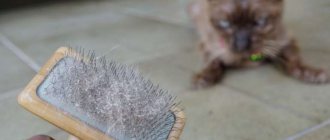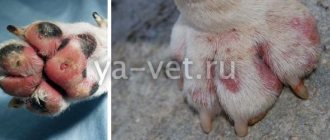Cheyletiellosis is a parasitic disease that affects dogs, cats, rabbits and other rodents; It is also found in guinea pigs.
The disease is usually transmitted by contact and can even occur in a person who has close contact with their pet or animals in the nursery. However, this is observed only in 30% of cases, and it does not manifest itself in the same form as in animals, but in the form of an itchy papular rash on the skin.
What to do in such a situation? To get started, we recommend reading this article. This article describes in detail methods of controlling parasites. We also recommend that you consult a specialist. Read the article >>>
What is cheyletiellosis?
The name cheyletiellosis (cheyletiosis) of carnivores refers to the disease of dogs and cats caused by cheyletiella mites. In addition to these pets, skin mites attack rabbits, rats and chinchillas. However, the herbivorous fur-bearing animal is inhabited by individuals of a different species.
Article continues after advertisement
Cheyletiellosis is a contagious disease that quickly spreads between relatives, as well as animals of different species, as parasites actively move along the coat and skin.
The disease is typical for all seasons of the year. But the parasite is unstable in the external environment: if a tick misses and falls while moving from one victim in winter, it will not be able to remain viable for more than a day. In summer, the parasite has more time to attack a new victim - as much as 5 days.
Arthropod parasites in appearance resemble scales of exfoliated epidermis, which is why the disease has received a second name - wandering dandruff.
In humans, when affected by cheyletella, prurigo (prurigo) develops, characterized by nodular papular rashes. When scratching, bloody crusts appear on the back, lower back, and extensor surfaces of the arms and legs.
Demodicosis
Most often, demodicosis in dogs is caused by mites of the genus Demodex canis, which live deep in the thickness of the skin - in the hair follicles and sebaceous glands.
Peculiarities
The mechanism of development and course of demodicosis is more complex than with other tick-borne diseases, in no small part due to the significant role of immune factors.
Demodex-infested skin (left) compared to clean dog skin (right). Illustration: Phizer atlas of veterinary clinical parazitology
A common view is that demodex is normally present on the skin without causing disease, but the results of a number of studies cast doubt on this. There is no doubt that the disease develops with a sharp increase in the number of ticks (this occurs with a general decrease in the dog’s immunity).
Due to the deep location of the ticks, demodicosis is almost not transmitted, with the exception of prolonged contact with a sick animal. Almost 100% of this occurs when the offspring are fed by a mother with demodicosis.
At-risk groups
As mentioned above, the disease can develop as a result of long-term direct contact with a sick animal (especially dairy puppies with a carrier mother).
In addition, a dog can get demodicosis under conditions accompanied by a general decrease in immunity, such as:
- pregnancy;
- stress;
- age (young and old animals);
- pathological immunodeficiency (congenital or acquired).
Veterinary experts also note that this disease is more common in purebred dogs, especially in short-haired breeds - some dogs have been proven to be predisposed to the disease due to a genetically determined decrease in specific immunity.
In general, the role of immunodeficiency is leading in the development of demodicosis - the disease often manifests itself after the use of drugs that suppress the immune system (for example, glucocorticoids, which are widely used because of their anti-inflammatory and antiallergic effects).
Symptoms of demodicosis
The course of the disease can occur in two forms: localized and generalized.
Localized form of demodicosis.
Localized form of demodicosis. Photo: Zharkikh E.V. (Vetmedical) There is a slight loss of hair on the dog's face and front legs, and later itching and redness of the skin may appear. In most cases, at this stage, demodicosis can be easily treated, even self-recovery, if the animal’s immunity returns to normal. If the animal does not receive proper timely treatment or the immune response is insufficient, the disease can develop into a generalized form, which is much more severe. Incorrect treatment (use of glucocorticoids in the event of an erroneous diagnosis) also leads to this.
Generalized demodicosis.
The areas of baldness increase, gradually merging into one. The dog's skin turns red, swells and thickens; acne, pustules (including bleeding ones), scales and drying out crusts can form on it. Secondary microflora (bacterial and fungal) develops on the affected skin, which causes constant itching and an unpleasant, pungent odor.
Doberman with generalized demodicosis. Photo: Simironin E.E. (Vetmedical)
The generalized form of demodicosis requires competent long-term complex treatment under the supervision of a veterinary specialist.
Pathogens of cheyletiellosis
The causative agents of the disease are ticks Cheyletiella blakei and Cheyletiella yasguri. These are parasites up to 0.5 mm in size: females are larger than males. Cheyletiella hair mites undergo a developmental cycle that includes protonymph and deutonymph stages. Heyletella lays a fertilized egg on a hair, attaching it with a sticky secretion. The time after which the larva hatches depends on external factors and ranges from 3 to 15 days.
The first stage lasts from 3 to 5 days: the larva molts and turns into a protonymph. The duration of the second stage is from 5 to 10 days, after which another metamorphosis occurs: the deutonymph hatches. The development cycle ends after one or two weeks. Only then does the arthropod acquire sex and become male or female. The lifespan of a tick from egg to mature individual is on average 21 days.
Routes of infection
Cheyletiellosis is contagious: the spread of tick-borne infestation is facilitated by overcrowding and unsanitary conditions. The disease spreads easily among the inhabitants of nurseries and shelters, because there are many animals in a small area. Yard cats are also not free from parasites. Moreover, a compassionate cat lover is able to bring guests to his pet simply by petting the yard cat.
The cheyletella mite in cats is similar to an inhabitant of a residential area on the outskirts of the city: it lives on the hair and descends onto the skin to feed. If several pets live in a room, infection can occur without close contact. An arthropod that falls from one cat ends up on the litter, and from there it moves to a new victim.
Article continues after advertisement
After interacting with an infested pet, a person develops pruritus. When the contact stops, the itching disappears. The owner relaxes and begins to caress the pet again - the scratchiness returns. A person uninitiated in the intricacies of parasitology may think that he is allergic to a cat.
But nothing is known about the facts of tick transmission from one person to another.
It is possible to defeat parasites!
Antiparasitic Complex® - Reliable and safe removal of parasites in 21 days!
- The composition includes only natural ingredients;
- Does not cause side effects;
- Absolutely safe;
- Protects the liver, heart, lungs, stomach, skin from parasites;
- Removes waste products of parasites from the body.
- Effectively destroys most types of helminths in 21 days.
There is now a preferential program for free packaging. Read expert opinion.
Read further:
Worms in rabbits: manifestation, what to do, how and with what to treat, methods of prevention
Long worms in cats: main types, description and methods of treating parasites in cats
No to ticks: where to order insect repellent treatment?
Entomoses in cats and dogs, humans: pathogen, symptom, treatment and prevention
Gnathostomosis in dogs, cats and humans: symptoms, description, routes of infection and treatment methods
Cucumber tapeworm in cats and dogs: symptoms and methods of treating dipylidia
Symptoms of cheyletiellosis
Not all infected pets show symptoms of the disease. Cheyletella causes skin itching and flaking in a cat prone to allergic manifestations. The scales peel off and fall off in pieces resembling human dandruff. Parasites are also similar in shape and color to grains of frozen secretion from the sebaceous glands. They move through the hair - it seems that dandruff is walking on the cat's skin. However, such wandering is more common in dogs.
In addition, pets lick themselves and remove most of the ticks. Due to the active work of the rough tongue, hairs are torn out of the skin - foci of alopecia (baldness) are formed.
Most of the particles occur in the center of the back. Each animal reacts to the movement of parasites in its own way. For some, mites do not cause severe itching, but dandruff looks like an annoying cosmetic defect. Other pets develop severe pruritis (itching) - scratching occurs. Then secondary microflora joins in, papules are formed, which mature and open. The leaking exudate dries out, crusts form, under which ideal conditions arise for the proliferation of putrefactive microflora.
Description
Cheyletiellosis is one of the diseases that are easily transmitted from sick animals to healthy ones.
In addition to cats, the disease affects representatives of dog breeds, guinea pigs, hamsters, and rabbits. Moreover, each type of pathogen lives on the skin of a specific animal species. Cheyletiellosis poses a danger to humans. The causative agent of the disease can temporarily live on his body, causing the appearance of an itchy rash, small erythematous papules on the arms and torso. According to doctors, owners of sick cats become infected in 30% of cases.
Basically, cheyletiellosis is accompanied by moderately severe symptoms and may have common features with manifestations of allergies. Adult animals often tolerate it without obvious signs or severe deterioration in health. It is quite difficult for young and elderly pets.
Being asymptomatic, the disease does not become less dangerous and is instantly transmitted from the carrier to others. Its spread is activated under poor conditions for keeping pets and overcrowding of animals.
Independent attempts to cure a cat often end in vain. If signs of pathology appear, it is mandatory to contact a veterinarian
Diagnostics
Diagnosis consists of detecting cheyletiella in cats by scraping the affected skin. However, parasites are not always detectable. Sometimes the study is carried out after the application of an insectoacaricidal agent. The ticks died; they could not be found. The cat's owner calms down. But no drugs can destroy arthropod eggs. The larvae hatch from them and the disease resumes. Therefore, the method involves taking up to five samples for microscopy.
The study is labor-intensive, but it is necessary when it is necessary to exclude fungal infections. This is relevant if children who experience itchy skin come into contact with a sick pet.
In addition to microscopy of scrapings, the following methods for detecting cheyletiella are used:
- microscopy of a print from wool taken when applying tape;
- searching for parasites using a magnifying glass;
- combing dandruff onto dark paper allows you to detect moving mites;
- method of diagnosing cheyletiellosis by treatment: in this case, the use of insectoacaricidal agents gives a positive result - and the symptoms disappear.
When diagnosing cheyletiellosis, it is necessary to exclude the following diseases.
- Fungal infections. Their treatment is long, the drugs used are characterized by side effects.
- Demodicosis and notoedrosis. It is more difficult to destroy subcutaneous mites than to deal with skin mites.
- Allergies: Taking a history is important. When a cat owner constantly uses insectoacaricidal drugs and still experiences dandruff and itching, then cheyletiellosis is ruled out.
It is advisable not to treat the animal on your own, but to immediately contact a veterinarian. This will help make a correct diagnosis and avoid poisoning the animal with unnecessary chemicals if ticks are not detected.
Article continues after advertisement
How to correctly diagnose the disease
When making a diagnosis, it is necessary to differentiate cheyletiellosis from food allergies, dermatitis of various etiologies, seborrhea, metabolic disorders, etc. That is why the dog owner must contact a dermatologist at the RosVet EC. Treatment “at random” is unacceptable, since the spread of the tick is dangerous for other pets.
What must be excluded when making a diagnosis:
- staphylococcal pyoderma (nodules with pus, culture is done to identify staphylococcus);
- seborrhea (dandruff appears due to excessive production of sebum, accompanied by severe dry hair and an unpleasant odor);
- demodicosis (parasitization of demodex mites, scraping is done and the parasite is identified under a microscope);
- allergies (the provoking factor for a skin reaction can be any food, medicine, fleas, etc.; a blood test reveals an increased level of eosinophils);
- sarcaptosis (itching blisters, scratching with blood and a characteristic tilt of the head);
- pediculosis (detection of a skin parasite).
Cheyletiellosis can be detected without the use of special laboratory methods and devices. But it would be more effective to take a scraping, place a piece of skin on a glass slide and visualize the skin parasite.
Sometimes, when an accurate diagnosis is not possible, a trial dose of the drug Fipronil is used. If the reaction is positive and the number of severe symptoms decreases, we can talk about cheyletiellosis.
How to treat cheyletiellosis in cats?
The following external and systemic medications are used to treat cheyletiellosis in cats.
- Bars Spot-on drops are used to treat cheyletiellosis, lice, fleas, subcutaneous ticks and helminths. The drug is poured into 0.3 ml pipettes - for kittens weighing up to 1 kg. For animals from 1 to 5 kg, one 1 ml pipette is squeezed onto the skin of the withers; for larger cats - two pipettes.
- Stronghold drops are used against cheyletiellosis, ectoparasites, helminths, and subcutaneous mites. For cats weighing less than 2.5 kg, apply the contents of pipettes with a purple cap to clean skin. They contain 0.25 ml with 6% selamectin. For animals weighing more than 2.5 kg, use a blue-colored ampoule with a volume of 0.75 ml.
- Bravecto drops are used to protect your pet from fleas, ticks and cheyletiellosis pathogens. The drug is not recommended for animals weighing less than 1.2 kg. For cats up to 2.8 kg, apply 0.4 ml of the drug to intact, clean skin. For animals weighing 2.8-6.2 kg, pipettes of 0.89 ml are produced.
To avoid re-infection, all animals in the house are treated, even if parasites are found in only one. After applying the drug, while the liquid dries (about half an hour), animals should be isolated in different rooms so that they do not lick the drug from each other’s fur. Or you can wear neck collars.
If the medicine gets on the mucous membranes, poisoning is possible. Therefore, you need to apply the drug strictly to the withers, where the cat cannot reach with its tongue.
Prevention
To prevent infection with cheyletiellosis and other types of parasites, products that are used for treatment are used, as well as drops “Advocate”, “IN-AP complex”, “Inspector”, “Fiprist” and others. The duration of protection is indicated in the instructions attached to the drug.
Finally, it is worth noting that a strong immune system of a healthy cat will not allow skin mites to actively reproduce. Therefore, animals that are in comfortable conditions and eat nutritious food, as a rule, do not get sick, even if they are infected with ticks. That is, an important aspect of prevention is a healthy lifestyle for your pet.
Rate and share!
Treatment Options
The disease must be treated with antiparasitic drugs, which are administered subcutaneously or superficially. In the first case, the infected pet is given injections, and in the second, its skin is treated with drops, aerosols or aqueous emulsions.
Drugs
Cheyletiellosis in dogs treatment:
- Ivermectin is a broad-spectrum drug that is prescribed against scabies mites and various types of worms. The medicine is a sterile solution, which is produced in ampoules or large bottles. The drug is administered subcutaneously every 2 weeks. The course consists of three injections.
- Fironil is an insecticidal acaricidal spray that needs to be sprayed onto the fur and the procedure repeated after a month.
- Lime sulfide is used in medicinal baths. The dog needs to be dipped in it for 6 weeks. The procedure is performed once a week.
- Aqueous emulsions of pyrethroids are used for spraying or wiping pets. These include stomozan, neostomozan, ectomin, butox, etc.
Only a veterinarian knows how to treat cheyletiosis in dogs. He prescribes the dosage and frequency of the selected drug, determines the stage of the disease and monitors the condition of the animal. Not only the infected dog should be treated for ticks, but also all pets with whom it has come into contact.











